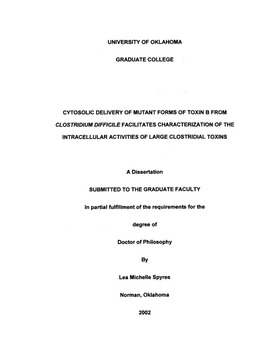| dc.description.abstract | Clostridia are gram-positive spore-forming organisms responsible for a variety of diseases in both humans and animals Three species of Clostridia- Clostridium difficile, Clostridium sordellii and Clostridium novyi- produce a unique class of toxins termed large clostridial toxins (LCTs). These toxins inactivate members of the Ras superfamily of mammalian GTPases by glycosylation. LCTs are important in a variety of diseases, for example, Toxin A (TcdA) and toxin B (TcdB) are the major virulence factors in C. difficile associated diarrhea and pseudomembranous colitis. Whereas Clostridium sordellii lethal toxin (TcsL) and Clostridium novyi alpha toxin (Tcnalpha) have been implicated in gas gangrene infections. In addition to their roles in disease, TcdB and TcsL have been extensively used to decipher the effects of inactivating Ras proteins in mammalian cells. In order to better understand the role of these toxins in inactivating Ras proteins, we have undertaken the molecular characterization of intoxication by two LCTs, TcsL and TcdB. A chimeric fusion protein consisting of the TcdB enzymatic domain fused to the binding and translocation regions of anthrax lethal toxin (LFnTcdB1-556) was able to confer cytopathic effects on tissue culture cells and in a mouse, when delivered with the protective antigen (PA) component of anthrax toxin. Fusions containing mutants in the enzymatic domain of TcdB (LFnTcdB1-500, LFnTcdB 1-420 LFnTcdB1-170, LFnTcdB35-556, LFnTcdB 67-556, LFnTcdBC365S, LFnTcdBC365W LFnTcdB W102A) were inactive for glucosylation and CPE on cells, with the exception of LFnTcdBC365S and LFnTcdB1-170. The fusion proteins attenuated in enzymatic activity acted as inhibitors of TcdB both in vivo and in vitro. LFnTcdB1-500 was also able to inhibit the activity of TcsL and slowed cell rounding in transformed mammalian cells expressing the enzymatic domain of TcdB indicating the competition was occurring inside the cytosol. A combination of the lysosomotropic agent Bafilomycin A1 and the LFnTcdB1-500 inhibitor was used to determine the time required for cytosolic entry and irreversible cytopathic effects after treatment with TcdB. Furthermore, the time required for TcsL cytosolic entry was found to be considerably slower than that of TcdB accounting for the lower CPE of TcsL compared to TcdB. | en_US |
